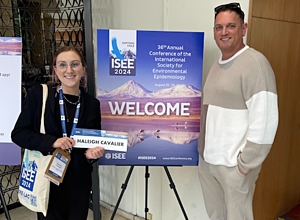This past August, the International Society for Environmental Epidemiology (ISEE) held their 36th annual conference in Santiago, Chile. Framed by stunning views of the Andes and the haze of smog trapped by the city's thermal inversions, scientists from across the globe gathered to share their cutting-edge environmental health research.
As a late-stage PhD student, I presented my work on the e-cigarette exposome — an exciting opportunity. But equally exciting was the chance to attend sessions led by the top scientists whose work I have long cited.
I was most excited for one session in particular: “Why Countering Harmful Industry Impacts and Exposures on Health is Critical for Environmental Justice,” co-chaired by Dr. Tracey Woodruff and Dr. Nick Chartres. This session explained the concept of “Industrial Epidemics” — a term used to describe how corporate products and practices can negatively impact public health, while the industries behind them strategically shape science and policy in their favor.
A defining early career experience
My interest in this symposium was primed by a pivotal experience early in  my PhD. While working on a review article on the carcinogenic effects of pesticides, I noticed a troubling pattern in the literature. Reviews emphasizing null findings and studies critiquing existing epidemiological methods, while appearing neutral at first, were consistently funded by industry. They seemed systematically designed to create doubt, downplay the harms of pesticides, and draw conclusions that conveniently aligned with corporate interests.
my PhD. While working on a review article on the carcinogenic effects of pesticides, I noticed a troubling pattern in the literature. Reviews emphasizing null findings and studies critiquing existing epidemiological methods, while appearing neutral at first, were consistently funded by industry. They seemed systematically designed to create doubt, downplay the harms of pesticides, and draw conclusions that conveniently aligned with corporate interests.
I quickly became adept at predicting which studies were industry-backed just by reading their abstracts. This experience was revelatory. It led me to question the integrity of such research and ignited a lasting interest in the topic that I brought with me to ISEE 2024.
Exposing industry tactics
At the symposium, Dr. Tracey Woodruff kicked off the discussion with a compelling analogy: she framed corporations as modern vectors of disease — akin to biological organisms transmitting toxic exposures to populations. The “Industrial Epidemics” she discussed included the striking increase in non-communicable diseases and premature deaths caused by tobacco, industrial chemicals, fossil fuel production, ultra-processed foods, and others, and how this is enabled by a global economic system that “prioritizes wealth creation over health creation.”
Dr. Lisa Bero followed with a presentation focused on the research process, revealing how industry funding can introduce bias at every stage, from how research questions are framed to how results are published. Bero shared findings from her meta-research that showed industry-sponsored studies are significantly more likely to produce favorable results for corporate interests, and that current risk of bias tools — the systematic guidelines for evaluating study quality when doing systematic reviews and chemical classifications — are ill-equipped to detect this. She stressed that transparency alone is insufficient to address these issues, and called for more structural reforms, such as public prioritization of research agendas and funding, as well as eliminating financial ties between industry and researchers.
Dr. Yogi Hendlin offered a case study on glyphosate, showing how corporate influence infiltrates regulatory processes. He explained how Monsanto’s influence on agencies like the US EPA and the European Food Safety Authority (EFSA) led to “regulatory plagiarism,” where industry-written documents were copied directly into official regulatory reports. Despite evidence of glyphosate's carcinogenic risks and classification as a probable carcinogen by the International Agency for Cancer Research (IARC), regulatory bodies continued to side with industry-funded research over independent studies.
Dr. Nick Chartres discussed how corporations collaborate strategically to capture knowledge, the policy/regulatory process, and influence public discourse, using examples from UCSF’s Industry Documents Library. He used a case study of how the tobacco industry successfully fought to undermine US EPA regulations of the pesticide phosphine. If implemented, those regulations would threaten the tobacco industry's profits. The case study revealed a longstanding playbook of tactics to undermine regulation, including hiring a former US EPA scientist to argue (successfully) against the proposed regulation, thus ensuring that profits came before public health.
Dr. Kurt Straif added another critical layer by addressing the challenges of preventing industry manipulation during the publication process. He pointed out that industries often go as far as blocking the publication of unfavorable studies, pressing for the withdrawal of accepted research, or ghostwriting articles to skew public perception. Straif emphasized the importance of updating risk of bias tools to include conflict-of-interest domains, which would help ensure that industry influence is flagged in the research process.
Dr. Laura Vandenberg concluded by discussing a qualitative analysis of five disparate industries/organizations (tobacco, coal, and sugar industries, pesticide manufacturers, and a climate change research institute), that revealed five key tactics used to create doubt: attack study design, gain support from reputable individuals, misrepresent data, employ hyperbolic language, and influence government/laws. She emphasized the need for researchers to recognize these tactics and advocated for training scientists and the public to spot logical fallacies and bias.
A room energized for change
Noticeable to me was a tangible energy and sense of urgency among the audience — a feeling that this dialogue was not only necessary but overdue. This session drew more questions and engagement than any other I attended, and attendees were eager to continue the conversation.
It was clear that environmental epidemiology researchers want a platform to discuss these issues. We frequently confront commercially inconvenient findings that threaten powerful industries. It is crucial that we develop strategies to navigate this minefield while maintaining scientific integrity.
Looking forward
The symposium underscored the growing momentum to expose and counter corporate influence on environmental health. New initiatives, such as UCSF's Partnership to Analyze and Counter Industry Health Harms and CHE’s current initiative to protect researchers experiencing industry pressure, are at the forefront of investigating how corporate practices disproportionately harm vulnerable communities. Ongoing research into conflicts of interest, including work on PFAS, aims to ensure that public policy is guided by independent, unbiased science.
As researchers continue to shed light on these harmful industry tactics, the push for transparency, accountability, and independent research will play a crucial role in shaping the future of environmental health, health equity, and scientific integrity.


